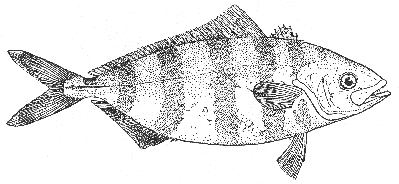Rudderfish Seriola zonata (Mitchill) 1815 [50]
AMBERJACK; PILOTFISH
[Jordan and Evermann, 1896-1900, p. 902]

Figure 198.—Rudderfish (Seriola zonata), young in striped stage, Wellfleet, Mass. After Storer.
Description—
The rudderfish is deeper bodied, relatively, than the pilotfish (body about three and one-half times as long as deep), so much flattened sideways that it is almost as thin as a butterfish (p. 363), and with a pointed nose. Its first (spiny) dorsal fin is well developed, with 7 spines. There are 36 to 38 rays in the second dorsal fin (only 26 or 27 in the pilotfish) and the ventrals are relatively much longer than in the pilot. In young fry of 2 or 3 inches the second dorsal originates a little in front of the tips of the pectorals, but it originates slightly behind the tips of the pectorals by the time the fish has grown to 8 or 9 inches, and still farther back in large specimens.[51]
The anal fin (20 or 21 rays) is a little more than half as long as the second dorsal in the rudderfish, as it is in the pilotfish also. And in young fish it is preceded by one or two short spines which adults lack.
The ventrals are a little longer than the pectorals, and more pointed in large fish than in small; the caudal fin is deeply forked, its slender penduncle with a longitudinal keel on each side; the mouth gapes back to the forward margin of the eye and is armed with with broad bands of hairlike teeth. The body is clad with small scales.
[page 374]Color—
Bluish or silvery brown above, paler on the sides, and white below. In young fish (no large ones have been reported from within our limits) the sides are conspicuously crossbarred with 5 or 6 broad dark blue or brown bands, the last 4 run up on the dorsal fin and the last 2 or 3 down on the anal fin. There also is a dark band running obliquely from the first dorsal to the eye in some cases. All of these bands fade with growth, however, to disappear in large fish. The first dorsal is black, the anal white at the base, the ventrals black above, pale below, and the caudal dusky green, with white tips.[52]
Size—
Maximum length about 3 feet.
General range—
Atlantic Coast of America, Halifax, Nova Scotia,[53] to Gulf of Mexico.
Occurrence in the Gulf of Maine—
The rudderfish is ordinarily a rare visitor to the Gulf of Maine, and most of those that have been seen there have been small, made conspicuous by their crossbarred pattern. Two were taken at Wellfleet in 1844 and 1849 (mentioned by Storer); another at Beverly in May 1866; one five inches long at Provincetown in 1870; and one at Salem sometime prior to 1879. A gap then follows in the record until September 1921, when one was caught by an angler fishing for smelt at a wharf in Portland Harbor.[54] Another, of 5½ inches was caught on September 22, 1929, also by an angler fishing for smelt; one of 6¼ inches was taken on Nantucket Shoals August 1, 1930;[55] several were reported in 1949 at Boothbay Harbor, the Sheepscot River, and at Gloucester.[56] However, in the summer and fall of the years 1949-51 large numbers of them were caught or observed in and around the traps at Barnstable, Cape Cod Bay, and one day's record catch by one set of pound nets, within this period, amounted to two barrels[57] indicating that, in some years, large schools of rudderfish are sometimes present in the latter region.
Small fry 1½ to 7 inches long are regular summer visitors at Woods Hole.
[50] The interrelationships of the several Seriolas that have been described from our South Atlantic coast still remain in doubt.
[51] We have examined specimens ranging from 3 to 9 inches in length taken in Cape Cod Bay, at Woods Hole, New Bedford, and other localities. Storer's illustration, reproduced here, was of a 2-inch fish.
[52] We have no color notes from life.
[53] Reported by Leim, Proc. Nova Scotian Inst. Sci., vol. 17, 1930, No. IV, p. xlvi, as S. dumerili.
[54] Reported to us by Walter H. Rich.
[55] Reported by Firth, Bull. 61, Boston Soc. Nat. Hist.; 1931, p. 12.
[56] Reported by Scattergood, Trefethen, and Coffin, Copeia, 1951, p. 298.
[57] Information supplied by Frank Mather who was informed of the 1949-1951 catches at Barnstable by Capt. John Vetorino in whose traps many of these rudderfish were caught.